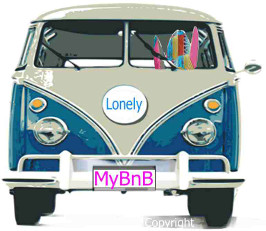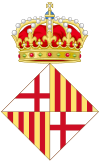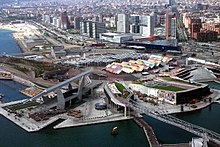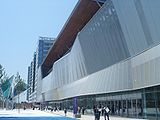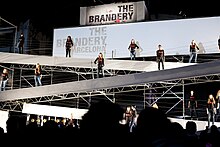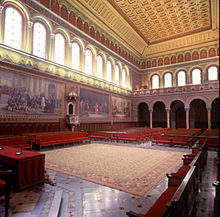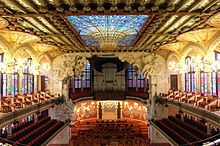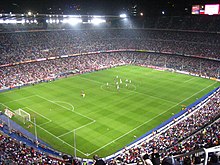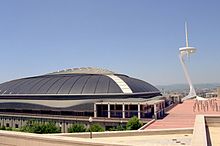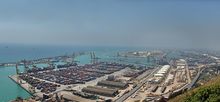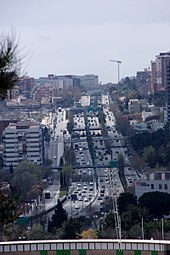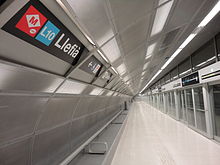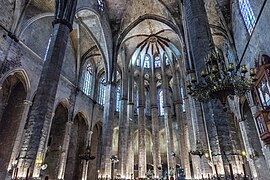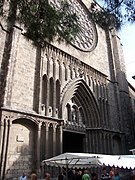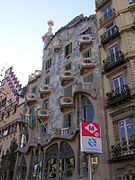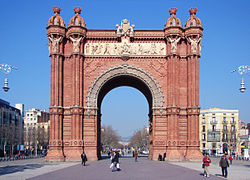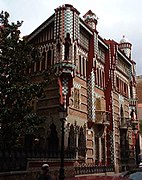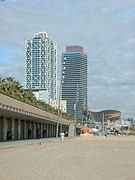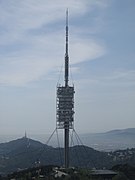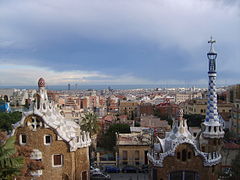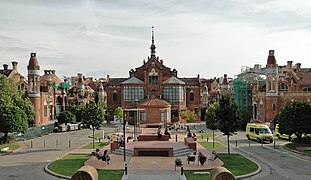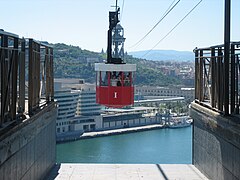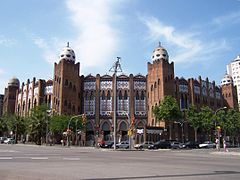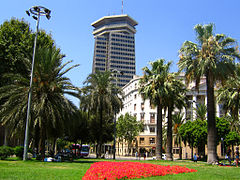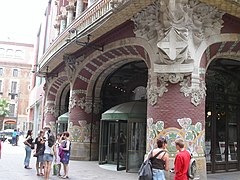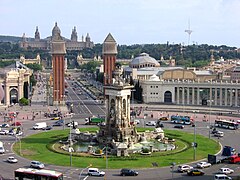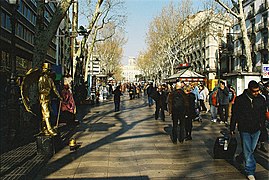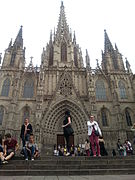Barcelona
From Wikipedia, the free encyclopedia
This article is about the city in Spain. For other uses, see Barcelona (disambiguation).
| Barcelona | |||
|---|---|---|---|
| City and Municipality | |||
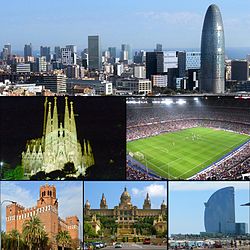 | |||
| |||
Nickname(s):Ciutat Comtal (ca)/Ciudad Condal (es)
"City of Counts" Cap i Casal de Catalunya (ca) "Head and Hearth of Catalonia" Abbreviation(s): Barna, BCN | |||
| Location of Barcelona within Spain | |||
| Coordinates: 41°23′N 2°11′ECoordinates: 41°23′N 2°11′E | |||
| Country | |||
| Autonomous community | |||
| Province | Barcelona | ||
| Comarca | Barcelonès | ||
| Seat | Barcelona City Hall | ||
| Districts | |||
| Government | |||
| • Type | Mayor–council | ||
| • Body | Barcelona City Council | ||
| • Mayor | Ada Colau Ballano[1](Barcelona en Comú) | ||
| Area[2] | |||
| • City | 101.4 km2 (39.2 sq mi) | ||
| Elevation (AMSL) | 12 m (39 ft) | ||
| Population (2015)[1] | |||
| • City | 1,604,555 | ||
| • Rank | 2nd (Spain) | ||
| • Density | 16,000/km2 (41,000/sq mi) | ||
| • Urban | 4,693,000[3] | ||
| • Metro | 5,375,774 | ||
| Demonym(s) | Barcelonan, Barcelonian barceloní, -ina (ca) 'barcelonés, -esa (es) | ||
| Postal code | 080xx | ||
| Area code | +34 (E) 93 (B) | ||
| INE code | 08 0193 | ||
| City budget(2014) | €2.5 billion[4] | ||
| Official language | Catalan and Spanish | ||
| Main festitivity | La Mercè | ||
| Patron saint | Eulalia of Barcelona | ||
| Website | www | ||
Barcelona (/bɑːrsəˈloʊnə/, Catalan: [bəɾsəˈlonə], Spanish: [barθeˈlona]) is the capital city of the autonomous community of Catalonia in the Kingdom of Spain, as well as the country's second most populous municipality, with a population of 1.65 million within city limits.[5] Its urban area extends beyond the administrative city limits with a population of around 4.7 million people,[6] being the seventh-most populous urban area in the European Union after Paris, London, Madrid, the Ruhr area, Berlin, andMilan.[3] It is the largest metropolis on the Mediterranean Sea, located on the coast between the mouths of the rivers Llobregat and Besòs, and bounded to the west by the Serra de Collserola mountain range, the tallest peak of which is 512 metres (1,680 ft) high.
Founded as a Roman city, in the Middle Ages Barcelona became the capital of the County of Barcelona. After merging with the Kingdom of Aragon, Barcelona continued to be an important city in the Crown of Aragon as an economic and administrative center of this Crown and the capital of the Principality of Catalonia. Besieged several times during its history, Barcelona has a rich cultural heritage and is today an important cultural center and a major tourist destination. Particularly renowned are the architectural works of Antoni Gaudí and Lluís Domènech i Montaner, which have been designated UNESCO World Heritage Sites. The headquarters of the Union for the Mediterranean is located in Barcelona. The city is known for hosting the 1992 Summer Olympics as well as world-class conferences and expositions and also many international sport tournaments.
Barcelona is one of the world's leading tourist, economic, trade fair and cultural centers, and its influence in commerce, education, entertainment, media, fashion, science, and the arts all contribute to its status as one of the world's major global cities.[7][8] It is a major cultural and economic center in southwestern Europe, 24th in the world (before Zürich, after Frankfurt)[9] and a financial center. In 2008 it was the fourth most economically powerful city by GDP in the European Union and 35th in the world with GDP amounting to €177 billion.[10] In 2012 Barcelona had a GDP of $170 billion; it is leading Spain in both employment rate and GDP per capita change.[11] In 2009 the city was ranked Europe's third and one of the world's most successful as a city brand.[12] In the same year the city was ranked Europe's fourth best city for business and fastest improving European city, with growth improved by 17% per year,[13] but it has since been in a full recession with declines in both employment and GDP per capita, with some recent signs of the beginning of an economic recovery.[14] Since 2011 Barcelona is a leading smart city in Europe.[15]Barcelona is a transport hub with the Port of Barcelona being one of Europe's principal seaports and busiest European passenger port,[16] an international airport,Barcelona–El Prat Airport, which handles above 40 million passengers per year,[17] an extensive motorway network and a high-speed rail line with a link to France and the rest of Europe.[18]
Contents
[hide]Names[edit]
The name Barcelona comes from the ancient Iberian Barkeno, attested in an ancient coin inscription found on the right side of the coin in Iberian script as  ,[19] inAncient Greek sources as Βαρκινών, Barkinṓn;[20][21] and in Latin as Barcino,[22] Barcilonum[23] and Barcenona.[24][25][26]
,[19] inAncient Greek sources as Βαρκινών, Barkinṓn;[20][21] and in Latin as Barcino,[22] Barcilonum[23] and Barcenona.[24][25][26]
Some older sources suggest that the city may have been named after the Carthaginian general Hamilcar Barca, who was supposed to have founded the city in the 3rd century BC,[27] but there is no evidence that Barcelona was ever a Carthaginian settlement, or that its name in antiquity, Barcino, had any connection with the Barcidfamily of Hamilcar.[28] During the Middle Ages, the city was variously known as Barchinona, Barçalona, Barchelonaa, and Barchenona.
Internationally, Barcelona's name is usually abbreviated as 'Barsa' or 'Barça'. Locally, this name refers only to FC Barcelona, the football club. Locals refer to the city instead as 'Barna'.
Another common abbreviation is 'BCN', which is also the IATA airport code of the Barcelona-El Prat Airport.
The city is also referred to as the Ciutat Comtal in Catalan, and Ciudad Condal in Spanish, owing to its past as the seat of the Count of Barcelona.
History[edit]
Main articles: History of Barcelona and Timeline of Barcelona
The origin of the earliest settlement at the site of present-day Barcelona is unclear. The ruins of an early settlement have been excavated in the El Raval neighborhood, including different tombs and dwellings dating to earlier than 5000 BC.[29][30] The founding of Barcelona is the subject of two different legends. The first attributes the founding of the city to the mythological Hercules. The second legend attributes the foundation of the city directly to the historical Carthaginian general, Hamilcar Barca, father ofHannibal, who supposedly named the city Barcino after his family in the 3rd century BC,[31] but there is no historical or linguistic evidence that this is true.[28]
In about 15 BC, the Romans redrew the town as a castrum (Roman military camp) centered on the "Mons Taber", a little hill near the contemporary city hall (Plaça de Sant Jaume). Under the Romans, it was a colony with the surname of Faventia,[32] or, in full, Colonia Faventia Julia Augusta Pia Barcino[33] or Colonia Julia Augusta Faventia Paterna Barcino. Pomponius Mela[34] mentions it among the small towns of the district, probably as it was eclipsed by its neighbour Tarraco (modern Tarragona), but it may be gathered from later writers that it gradually grew in wealth and consequence, favoured as it was with a beautiful situation and an excellent harbour.[35] It enjoyed immunity from imperial burdens.[36] The city minted its own coins; some from the era of Galba survive.
Important Roman vestiges are displayed in Plaça del Rei underground, as a part of the Barcelona City History Museum MUHBA; the typically Roman grid plan is still visible today in the layout of the historical center, the Barri Gòtic (Gothic Quarter). Some remaining fragments of the Roman walls have been incorporated into the cathedral.[37] The cathedral, also known as the Basilica La Seu, is said to have been founded in 343. The city was conquered by theVisigoths in the early 5th century, becoming for a few years the capital of all Hispania. After being conquered by the Arabs in the early 8th century, it was conquered in 801 byCharlemagne's son Louis, who made Barcelona the seat of the Carolingian "Hispanic March" (Marca Hispanica), a buffer zone ruled by the Count of Barcelona.
The Counts of Barcelona became increasingly independent and expanded their territory to include all of Catalonia, although on 6 July 985, Barcelona was sacked by the army ofAlmanzor.[38] The sack was so traumatic that most of Barcelona's population was either killed or enslaved.[39] In 1137, Aragon and the County of Barcelona merged in dynastic union[40][41] by the marriage of Ramon Berenguer IV and Petronilla of Aragon, their titles finally borne by only one person when their son Alfonso II of Aragon ascended to the throne in 1162. His territories were later to be known as the Crown of Aragon, which conquered many overseas possessions and ruled the western Mediterranean Sea with outlying territories in Naples and Sicily and as far as Athens in the 13th century. The forging of a dynastic link between the Crowns of Aragon and Castile marked the beginning of Barcelona's decline. The Bank of Barcelona, probably the oldest public bank in Europe, was established by the city magistrates in 1401. It originated from necessities of the state, as did the Bank of Venice(1402) and the Bank of Genoa (1407).[42]
The marriage of Ferdinand II of Aragon and Isabella I of Castile in 1469 united the two royal lines. Madrid became the center of political power whilst the colonization of the Americas reduced the financial importance (at least in relative terms) of Mediterranean trade. Barcelona was a center of Catalan separatism, including the Catalan Revolt (1640–52) against Philip IV of Spain. The great plague of 1650–1654 halved the city's population.[43]
In the 18th century, a fortress was built at Montjuïc that overlooked the harbour. In 1794, this fortress was used by the French astronomer Pierre François André Méchain for observations relating to a survey stretching to Dunkirk that provided the official basis of the measurement of a metre.[44] The definitive metre bar, manufactured from platinum, was presented to the French legislative assembly on 22 June 1799. Much of Barcelona was negatively affected by the Napoleonic wars, but the start of industrialization saw the fortunes of the province improve. Urban planner Ildefons Cerdà designed the large Eixample district in the 1850s when the medieval city walls around Barcelona's old town were torn down.[6]
During the Spanish Civil War, the city, and Catalonia in general, were resolutely Republican. Many enterprises and public services were "collectivized" by the CNT and UGT unions. As the power of the Republican government and the Generalitat diminished, much of the city was under the effective control of anarchist groups. The anarchists lost control of the city to their own allies, the Communists and official government troops, after the street fighting of the Barcelona May Days. The fall of the city on 26 January 1939, caused a mass exodus of civilians who fled to the French border. The resistance of Barcelona to Franco's coup d'état was to have lasting effects after the defeat of the Republican government. The autonomous institutions of Catalonia were abolished,[45] and the use of the Catalan language in public life was suppressed. Barcelona remained the second largest city in Spain, at the heart of a region which was relatively industrialized and prosperous, despite the devastation of the civil war. The result was a large-scaleimmigration from poorer regions of Spain (particularly Andalusia, Murcia and Galicia), which in turn led to rapid urbanization. The city gained vitality in 1992 when it hosted theSummer Olympics.[46]
Geography[edit]
Location[edit]
Barcelona is located on the northeast coast of the Iberian Peninsula, facing the Mediterranean Sea, on a plain approximately 5 km (3 mi) wide limited by the mountain range ofCollserola, the Llobregat river to the southwest and the Besòs river to the north.[47] This plain covers an area of 170 km2 (66 sq mi),[47] of which 101 km2 (39.0 sq mi)[48] are occupied by the city itself. It is 120 kilometres (75 miles) south of the Pyrenees and the Catalan border with France.
Tibidabo, 512 m (1,680 ft) high, offers striking views over the city[49] and is topped by the 288.4 m (946.2 ft) Torre de Collserola, a telecommunications tower that is visible from most of the city. Barcelona is peppered with small hills, most of them urbanized, that gave their name to the neighbourhoods built upon them, such as Carmel (267 metres or 876 feet), Putget (181 metres or 594 feet) and Rovira (261 metres or 856 feet). The escarpment of Montjuïc (173 metres or 568 feet), situated to the southeast, overlooks the harbour and is topped by Montjuïc castle, a fortress built in the 17–18th centuries to control the city as a replacement for the Ciutadella. Today, the fortress is a museum and Montjuïc is home to several sporting and cultural venues, as well as Barcelona's biggest park and gardens.
The city borders on the municipalities of Santa Coloma de Gramenet and Sant Adrià de Besòs to the north; the Mediterranean Sea to the east; El Prat de Llobregat andL'Hospitalet de Llobregat to the south; and Sant Feliu de Llobregat, Sant Just Desvern, Esplugues de Llobregat, Sant Cugat del Vallès, and Montcada i Reixac to the west. The municipality includes two small sparsely-inhabited exclaves to the north-west.
Climate[edit]
Main article: Climate of Barcelona
According to the Köppen climate classification, the city has a hot-summer Mediterranean climate (Csa),[50][51] with mild, relatively wet winters and hot, relatively dry summers. However, the relative winter drought and the significant summer rainfall are not typical of a Mediterranean climate and would put Barcelona in a transitional zone between thesemi-arid climate (both BSk and BSh) to the west and southwest (on the coast, Tarragona being borderline)[52] and the humid subtropical (Cfa) in Serra de Collserola to the north, where the Fabra Observatory receives just enough summer precipitation near or over 30 mm (1.2 in) to be classified as borderline.
Its average annual temperature is 21 °C (70 °F) during the day and 14 °C (57 °F) at night. The average annual temperature of the sea is about 20 °C (68 °F). In the coldest month – January, the temperature typically ranges from 7 to 17 °C (45 to 63 °F) during the day, 4 to 10 °C (39 to 50 °F) at night and the average sea temperature is 13 °C (55 °F).[53] In the warmest month – August, the typical temperature ranges from 26 to 32 °C (79 to 90 °F) during the day, about 23 °C (73 °F) at night and the average sea temperature is 26 °C (79 °F).[53] Generally – the summer / "holiday" season lasts about six months, from May to October. Two months – April and November – are transitional; sometimes the temperature exceeds 20 °C (68 °F), with an average temperature of 18–19 °C (64–66 °F) during the day and 10–13 °C (50–55 °F) at night. December, January and February are the coldest months, with average temperatures around 14 °C (57 °F) during the day and 7 °C (45 °F) at night. Large fluctuations in temperature are rare, particularly in the summer months. Because of the proximity to the warm sea, frosts are very infrequent in the city of Barcelona. In fact, only 1 day in the last 30 years was recorded with a temperature under the freezing mark.[54] Snow is infrequent, but it snows lightly once or twice in a decade.
Barcelona averages several rainy days per month (≥ 1 mm), and annual average relative humidity is 72%, ranging from 69% in July to 75% in October. Rainfall totals are highest in autumn and lowest in early summer. Sunshine duration is 2,524 hours per year, from 138 (average 4.5 hours of sunshine a day) in December to 310 (average 10 hours of sunshine a day) in July.[55]
| [hide]Climate data for Barcelona Can Bruixa – Barcelona city (1987–2010) | |||||||||||||
|---|---|---|---|---|---|---|---|---|---|---|---|---|---|
| Month | Jan | Feb | Mar | Apr | May | Jun | Jul | Aug | Sep | Oct | Nov | Dec | Year |
| Average high °C (°F) | 14.8 (58.6) | 15.6 (60.1) | 17.4 (63.3) | 19.1 (66.4) | 22.5 (72.5) | 26.1 (79) | 28.6 (83.5) | 29.0 (84.2) | 26.0 (78.8) | 22.5 (72.5) | 17.9 (64.2) | 15.1 (59.2) | 21.2 (70.2) |
| Daily mean °C (°F) | 11.8 (53.2) | 12.4 (54.3) | 14.2 (57.6) | 15.8 (60.4) | 19.3 (66.7) | 23.0 (73.4) | 25.7 (78.3) | 26.1 (79) | 23.0 (73.4) | 19.5 (67.1) | 14.9 (58.8) | 12.3 (54.1) | 18.2 (64.8) |
| Average low °C (°F) | 8.8 (47.8) | 9.3 (48.7) | 10.9 (51.6) | 12.5 (54.5) | 16.1 (61) | 19.8 (67.6) | 22.7 (72.9) | 23.1 (73.6) | 20.0 (68) | 16.5 (61.7) | 11.9 (53.4) | 9.5 (49.1) | 15.1 (59.2) |
| Average precipitation mm (inches) | 43.7 (1.72) | 31.4 (1.236) | 33.0 (1.299) | 47.7 (1.878) | 47.4 (1.866) | 25.5 (1.004) | 25.1 (0.988) | 40.8 (1.606) | 81.9 (3.224) | 96.5 (3.799) | 45.1 (1.776) | 46.8 (1.843) | 565.0 (22.244) |
| Average precipitation days (≥ 1 mm) | 6.0 | 5.0 | 6.2 | 7.9 | 7.5 | 5.5 | 3.1 | 5.8 | 8.0 | 8.0 | 6.6 | 7.0 | 76.6 |
| Source: Agencia Estatal de Meteorología – Barcelona City Hall[56] | |||||||||||||
Main sights[edit]
The Barri Gòtic (Catalan for "Gothic Quarter") is the center of the old city of Barcelona. Many of the buildings date from medieval times, some from as far back as the Roman settlement of Barcelona. Catalan modernista architecture (related to the movement known as Art Nouveau in the rest of Europe), developed between 1885 and 1950 and left an important legacy in Barcelona. Several of these buildings are World Heritage Sites. Especially remarkable is the work of architect Antoni Gaudí, which can be seen throughout the city. His best-known work is the immense but still unfinished church of the Sagrada Família, which has been under construction since 1882, and is still financed by private donations. As of 2007, completion is planned for 2026.
Barcelona was also home to Mies van der Rohe's Barcelona Pavilion. Designed in 1929 for the International Exposition for Germany, it is an iconic building that came to symbolize modern architecture as the embodiment of van der Rohe's aphorisms "less is more" and "God is in the details." The Barcelona pavilion was intended as a temporary structure, and was torn down in 1930 less than a year after it was constructed. A modern re-creation by Spanish architects now stands in Barcelona, however, constructed in 1986.
Barcelona won the 1999 RIBA Royal Gold Medal for its architecture,[57] the first (and as of 2015, only) time that the winner has been a city, and not an individual architect.
World Heritage Sites[edit]
 |  | 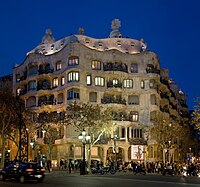 | 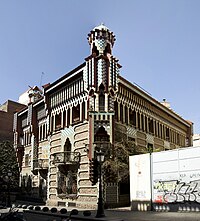 | |
| Name | Park Güell | Palau Güell | Casa Milà | Casa Vicens |
| Code, year | 320-001, 1984 | 320–002, 1984 | 320–003, 1984 | 320–004, 2005 |
| Coordinates | 41°24′59.6″N 2°09′07.9″E | 41.379183°N 2.174445°E | 41°23′51.3″N 2°09′46.9″E | 41°22′50.5″N 2°10′30.6″E |
 | 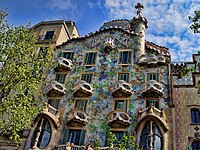 |  |  | |
| Name | Sagrada Família | Casa Batlló | Palau de la Música Catalana | Hospital de Sant Pau |
| Code, year | 320-005, 2005 | 320–006, 2005 | 804–001, 1997 | 804–002, 1997 |
| Coordinates | 41°24′19.8″N 2°10′30.2″E | 41°22′00.3″N 2°09′59.0″E | 41°23′16″N 2°10′30″E | 41°24′50″N 2°10′30″E |
Historic buildings and monuments[edit]
Further information: List of Modernista buildings in Barcelona
- Minor basilica of Sagrada Família, the international symbol of Barcelona
- Palau de la Música Catalana and Hospital de Sant Pau, designed by Lluís Domènech i Montaner, included in the UNESCO Heritage List in 1997.
- Works by Antoni Gaudí, including Park Güell, Palau Güell, Casa Milà (La Pedrera), Casa Vicens, Sagrada Família (Nativity façade and crypt), Casa Batlló, Crypt in Colonia Güell. The first three works were inscribed as a World Heritage Site in 1984. The other four were added as extensions to the site in 2005.
- The Cathedral of the Holy Cross and St. Eulalia (Gothic)
- Gothic basilica of Santa Maria del Mar
- Gothic basilica of Santa Maria del Pi
- Romanesque church of Sant Pau del Camp
- Palau Reial Major, medieval residence of the sovereign Counts of Barcelona, later Kings of Aragon
- The Royal Shipyard (gothic)
- Monastery of Pedralbes (gothic)
- The Columbus Monument
- The Arc de Triomf, a triumphal arch built for entrance to 1888 Barcelona Universal Exposition.
- Expiatory church of the Sacred Heart of Jesus on the summit of Tibidabo.
Museums[edit]
Main article: List of museums in Barcelona
Barcelona has a great number of museums, which cover different areas and eras. The National Museum of Art of Catalonia possesses a well-known collection of Romanesque art while the Barcelona Museum of Contemporary Art focuses on post-1945 Catalan and Spanish art. The Fundació Joan Miró, Picasso Museum and Fundació Antoni Tàpieshold important collections of these world-renowned artists, as well as Can Framis Museum, focused on post 1960 Catalan Art owned by Fundació Vila Casas. Several museums cover the fields of history and archeology, like the Barcelona City History Museum (MUHBA), the Museum of the History of Catalonia, the Archeology Museum of Catalonia, the Barcelona Maritime Museum and the private-owned Egyptian Museum. The Erotic museum of Barcelona is among the most peculiar ones, while Cosmocaixa is a science museum that received the European Museum of the Year Award in 2006. The FC Barcelona Museum has been the most visited museum in the city of Barcelona with 1506022 of visitors in 2013.
Parks[edit]
Barcelona contains sixty-eight municipal parks, of which twelve are historic parks, five are thematic (botanical) parks, forty-five are urban parks and six are forest parks.[59]They range from vest-pocket parks to large recreation areas. The urban parks alone cover 10% of the city (549.7 ha or 1,358.3 acres).[48] The total park surface grows about 10 ha (25 acres) per year,[60] with a proportion of 18.1 square metres (195 sq ft) of park area per inhabitant.[61]
Of Barcelona's parks, Montjuïc is the largest, with 203 ha located on the mountain of the same name.[48] It is followed by Parc de la Ciutadella (which occupies the site of the old military citadel and which houses the Parliament building, the Barcelona Zoo and several museums); 31 ha or 76.6 acres including the zoo), the Guinardó Park (19 ha or 47.0 acres), Park Güell (designed by Antoni Gaudí; 17.2 ha or 42.5 acres), Oreneta Castle Park (also 17.2 ha or 42.5 acres), Diagonal Mar Park (13.3 ha or 32.9 acres, inaugurated in 2002), Nou Barris Central Park (13.2 ha or 32.6 acres), Can Dragó Sports Park and Poblenou Park (both 11.9 ha or 29.4 acres), the Labyrinth Park (9.10 ha or 22.5 acres), named after the garden maze it contains.[48] There are also several smaller parks, for example, the Parc de les Aigües (2 ha or 4.9 acres). A part of the Collserolla Park is also within the city limits. PortAventura, one of the largest amusement parks in Europe with 3,000,000 visitors per year, is located one hour's drive from Barcelona.[62]Also, within the city lies Tibidabo Amusement Park, a smaller amusement park in Plaza del Tibidabo, with the Muntanya Russa amusement ride.
Beaches[edit]
Barcelona beach was listed as number one in a list of the top ten city beaches in the world according to National Geographic[63] and Discovery Channel.[64] Barcelona contains seven beaches, totalling 4.5 kilometres (3 miles) (2.8 mi) of coastline. Sant Sebastià, Barceloneta and Somorrostro beaches, both 1,100 m (3,610 ft) in length,[48] are the largest, oldest and the most-frequented beaches in Barcelona.
The Olympic Harbour separates them from the other city beaches: Nova Icària, Bogatell, Mar Bella, Nova Mar Bella and Llevant. These beaches (ranging from 400 to 640 m (1,310 to 2,100 ft) were opened as a result of the city restructuring to host the 1992 Summer Olympics, when a great number of industrial buildings were demolished. At present, the beach sand is artificially replenished given that storms regularly remove large quantities of material. The 2004 Universal Forum of Cultures left the city a large concrete bathing zone on the eastmost part of the city's coastline. Most recently Llevant, is the first beach to allow dogs access during summer season.
Demographics[edit]
According to Barcelona's City Council, Barcelona's population as of 1 June 2006 was 1,673,075 people,[65] on a land area of 101.4 km2 (39 sq mi). It is the main component of an administrative area of Greater Barcelona, with a population of 3,218,071 in an area of 636 square kilometres (246 square miles) (density 5,060 hab/km²). The population of the urban area was 4,223,000. It is the central nucleus of the Barcelona metropolitan area, which relies on a population of 5,083,000.[66]
The population density of Barcelona was 15,779 inhabitants per square kilometre (40,870/sq mi),[67] with Eixample being the most populated district. 62% of the inhabitants were born in Catalonia, with a 23.5% coming from the rest of Spain. Of the 17.4% from other countries, a proportion which has more than quadrupled since 2001 when it was 3.9%,[48] the majority come from (in order) Pakistan, Italy, China, Ecuador, Bolivia, and Morocco.[68] The province has the largest Muslim community in Spain, 322,698 people in Barcelona province are of Muslim faith.[69] The city also has the largest Jewish community in Spain, with an estimated 3,500 Jews living in the city.[70] There is a Japanese community clustered in Bonanova, Les Tres Torres, Pedralbes, and other northern neighborhoods, and a Japanese international school serves that community.[71]
Spanish is the most spoken language in Barcelona (according to the linguistic census held by the Government of Catalonia in 2013) and it is understood almost universally. After Spanish, Catalan language is the second most spoken one in the city, and it is understood by 95% of the population, while 72.3% can speak it, 79% can read it, and 53% can write it,[72] thanks to the language immersion educational system.
While most of the population state they are Roman Catholic (208 churches), a number of Muslims due to immigration (169 locations, mostly professed byMoroccans in Spain),[73] there are also a number of other groups, including Evangelical (71 locations, mostly professed by Roma), Jehovah's Witnesses(21 Kingdom Halls) and Buddhists (13 locations),[74] and Eastern Orthodox.[75]
In 1900, Barcelona had a population of 533,000 people,[47] which grew steadily but slowly until 1950, when it started absorbing a high number of people from other less-industrialized parts of Spain. Barcelona's population peaked in 1979 with 1,906,998 people, and fell throughout the 1980s and 1990s as more people sought a higherquality of life in outlying cities in the Barcelona Metropolitan Area. After bottoming out in 2000 with 1,496,266 people, the city's population began to rise again as younger people started to return, causing a great increase in housing prices.[76]
| Largest groups of foreign residents[77] | |
| Nationality | Population (2012) |
|---|---|
| 23,281 | |
| 22,909 | |
| 15,875 | |
| 15,511 | |
| 14,154 | |
| 13,674 | |
| 13,464 | |
| 12,328 | |
| 11,922 | |
| 8,482 | |
Population density[edit]
Note: This text is entirely based on the municipal statistical database provided by the city council.
Barcelona is one of the most densely populated cities in Europe. For the year 2008 the city council calculated the population to 1,621,090 living in the 102.2 km2 sized municipality, giving the city an average population density of 15,926 inhabitants per square kilometre.
In the case of Barcelona though, the land distribution is extremely uneven. Half of the municipality or 50.2 km2, all of it located on the municipal edge is made up of the ten least densely populated neighbourhoods containing less than 10% of the city's population, the uninhabited Zona Franca industrial area and Montjuïc forest park. Leaving the remaining 90% or slightly below 1.5 million inhabitants living on the remaining 52 square kilometres (20 square miles) at an average density close to 28,500 inhabitants per square kilometre.
Of the 73 neighbourhoods in the city, 45 had a population density above 20,000 inhabitants per square kilometre with a combined population of 1,313,424 inhabitants living on 38.6 km2 at an average density of 33,987 inhabitants per square km. The 30 most densely populated neighbourhoods accounted for 57.5% of the city population occupying only 22,7% of the municipality, or in other words, 936,406 people living at an average density of 40,322 inhabitants per square kilometre. The city's highest density is found at and around the neighbourhood of la Sagrada Família where four of the city's most densely populated neighbourhoods are located side by side, all with a population density above 50,000 inhabitants per square kilometre.
Religion[edit]
Main article: Religion in Barcelona
In a 2011 survey conducted by InfoCatólica, 49.5% of Barcelona residents of all ages identified themselves as Catholic.[78] This was the first time that more than half of respondents did not identify themselves as Catholic.[78] The numbers reflect a broader trend in Spain whereby the numbers of self-identified Catholics have declined.[78]
In 2014, 322,698 out of 5.5 million people in the province of Barcelona identified themselves as Muslim.[69][69]
Economy[edit]
General information[edit]
The Barcelona metropolitan area comprises over 66% of the people in one of the richest regions in Europe – Catalonia, with a GDP per capita amounting to €28,400 (16% more than the EU average). The Barcelona metropolitan area had a GDP amounting to $177 billion, equivalent to $34,821 in per capita terms (44% more than the EU average) making it the 4th most economically powerful city by GDP in the European Union and 35th in the world in 2009.[10] Barcelona city had a very high GDP of €80,894 per head in 2004, according to Eurostat.[79] Furthermore, Barcelona was Europe's fourth best business city and fastest improving European city, with growth improved by 17% per year as of 2009.[13]
Barcelona is the 14th most "livable city" in the world according to lifestyle magazine Monocle.[80] Similarly, according to Innovation Analysts 2thinknow, Barcelona occupies 13th place in the world on Innovation Cities™ Global Index.[81]
Barcelona has a long-standing mercantile tradition. Less well known is that the region was one of the earliest to begin industrialization in continental Europe, beginning with textile-related works from the mid-1780s but really gathering momentum in the mid-19th century, when it became a major center for the production of textiles and machinery. Since then, manufacturing has played a large role in its history.
Borsa de Barcelona (Barcelona Stock Exchange) is the main stock exchange in the northeastern part of the Iberian Peninsula.
Barcelona was recognized as the Southern European City of the Future for 2014/15, based on its economic potential,[82] by FDi Magazine in their bi-annual rankings.[83]
Trade fair and exhibitions[edit]
Drawing upon its tradition of creative art and craftsmanship, Barcelona is known for its award-winning industrial design. It also has several congress halls, notably Fira de Barcelona – the second largest trade fair and exhibition center in Europe, that host a quickly growing number of national and international events each year (at present above 50). The total exhibition floor space of Fira de Barcelona venues is 405,000 m2 (41 ha), not counting Gran Via center on the Plaza de Europa. However, the Eurozone crisisand deep cuts in business travel affected the Council's positioning of the city as a convention center.
An important business center, the World Trade Center Barcelona, is located in Barcelona's Port Vell harbour.
The city is known for hosting well as world-class conferences and expositions, including the 1888 Exposición Universal de Barcelona, the 1929 Barcelona International Exposition (Expo 1929), the 2004 Universal Forum of Cultures and the 2004 World Urban Forum.[citation needed]
Tourism[edit]
Barcelona was the 20th-most-visited city in the world by international visitors and the fifth most visited city in Europe after London, Paris, Istanbul and Rome, with 5.5 million international visitors in 2011.[84] By 2015, both Prague and Milan had more international visitors.[85] With its Rambles, Barcelona is ranked the most popular city to visit in Spain.[86]
Barcelona as internationally renowned a tourist destination, with numerous recreational areas, one of the best beaches in the world,[63][87] mild and warm climate, historical monuments, including eight UNESCOWorld Heritage Sites, 519 hotels as of March 2016[88] including 35 five star hotels,[89] and developed tourist infrastructure.
Manufacturing sector[edit]
Industry generates 21% of the total gross domestic product (GDP) of the region,[90] with the energy, chemical and metallurgy industries accounting for 47% of industrial production.[91] The Barcelona metropolitan area had 67% of the total number of industrial establishments in Catalonia as of 1997.[92]
Barcelona has long been an important European automobile manufacturing center. Formerly there were automobile factories of AFA, Abadal, Actividades Industriales, Alvarez, America, Artés de Arcos, Balandrás, Baradat-Esteve, Biscúter, J. Castro, Clúa, David, Delfín, Díaz y Grilló, Ebro trucks, Edis, Elizalde, Automóviles España,Eucort, Fenix, Fábrica Hispano, Auto Academia Garriga, Fábrica Española de Automóviles Hebe, Hispano-Suiza, Huracán Motors, Talleres Hereter, Junior SL, Kapi, La Cuadra, M.A., Automóviles Matas, Motores y Motos, Nacional Custals, National Pescara, Nacional RG, Nacional Rubi, Nacional Sitjes, Automóviles Nike, Orix, Otro Ford,Partia, Pegaso, PTV, Ricart, Ricart-España, Industrias Salvador, Siata Española, Stevenson, Romagosa y Compañía, Garaje Storm, Talleres Hereter, Trimak, Automóviles Victoria, Manufacturas Mecánicas Aleu.[93][94]
Today, the headquarters and a large factory of SEAT (the largest Spanish automobile manufacturer) are in one of its suburbs. There is also a Nissan factory in the logistics and industrial area of the city.[95] The factory of Derbi, a large manufacturer of motorcycles, scooters and mopeds, also lies near the city.[96]
As in other modern cities, the manufacturing sector has long since been overtaken by the services sector, though it remains very important. The region's leading industries are textiles, chemical, pharmaceutical, motor, electronic, printing, logistics, publishing, telecommunications and information technology services.
Fashion[edit]
The traditional importance of textiles is reflected in Barcelona's drive to become a major fashion center. There have been many attempts to launch Barcelona as a fashion capital, notably Gaudi Home.[citation needed]
Beginning in the summer of 2000, the city hosted the prestigious Bread & Butter urban fashion fair until 2009, when its organisers announced that it would be returning toBerlin. This was a hard blow for the city as the fair brought €100 m to the city in just three days.[97][98]
Since 2009, The Brandery, an urban fashion show, has been held in Barcelona twice a year. In 2012, Barcelona was named as the third most important fashion capitalaccording to the Global Language Monitor’s annual ranking of the world's top fifty fashion capitals.[99]
Government and administrative divisions[edit]
See also: Municipal elections in Barcelona and List of mayors of Barcelona
As the capital of the autonomous community of Catalonia, Barcelona is the seat of the Catalan government, known as the Generalitat de Catalunya; of particular note are theexecutive branch, the parliament, and the Supreme Court of Catalonia. The city is also the capital of the Province of Barcelona and the Barcelonès comarca (district).
Barcelona is governed by a city council formed by 41 city councillors, elected for a four-year term by universal suffrage. As one of the two biggest cities in Spain, Barcelona is subject to a special law articulated through the Carta Municipal (Municipal Law). A first version of this law was passed in 1960 and amended later, but the current version was approved in March 2006.[100] According to this law, Barcelona's city council is organized in two levels: a political one, with elected city councillors, and one executive, which administrates the programs and executes the decisions taken on the political level.[101] This law also gives the local government a special relationship with the central government and it also gives the mayor wider prerogatives by the means of municipal executive commissions.[102] It expands the powers of the city council in areas like telecommunications, city traffic, road safety and public safety. It also gives a special economic regime to the city's treasury and it gives the council a veto in matters that will be decided by the central government, but that will need a favourable report from the council.[100]
The Comissió de Govern (Government Commission) is the executive branch, formed by 24 councillors, led by the Mayor, with 5 lieutenant-mayors and 17 city councillors, each in charge of an area of government, and 5 non-elected councillors.[103] The plenary, formed by the 41 city councillors, has advisory, planning, regulatory, and fiscal executive functions.[104] The six Commissions del Consell Municipal (City council commissions) have executive and controlling functions in the field of their jurisdiction. They are composed by a number of councillors proportional to the number of councillors each political party has in the plenary.[105] The city council has jurisdiction in the fields of city planning, transportation, municipal taxes, public highways security through the Guàrdia Urbana (the municipal police), city maintenance, gardens, parks and environment, facilities (like schools, nurseries, sports centers, libraries, and so on), culture, sports, youth and social welfare. Some of these competencies are not exclusive, but shared with the Generalitat de Catalunya or the central Spanish government. In some fields with shared responsibility (such as public health, education or social services), there is a shared Agency or Consortium between the city and the Generalitat to plan and manage services.[106]
The executive branch is led by a Chief Municipal Executive Officer which answers to the Mayor. It is made up of departments which are legally part of the city council and by separate legal entities of two types: autonomous public departments and public enterprises.[107]
The seat of the city council is on the Plaça de Sant Jaume, opposite the seat of Generalitat de Catalunya. Since the coming of the Spanish democracy, Barcelona had been governed by the PSC, first with an absolute majority and later in coalition with ERC and ICV. After the May 2007 election, the ERC did not renew the coalition agreement and the PSC governed in a minority coalition with ICV as the junior partner.
After 32 years, on 22 May 2011, CiU gained a plurality of seats at the municipal election, gaining 15 seats to the PSC's 11. The PP hold 8 seats, ICV 5 and ERC 2.
Districts[edit]
Main article: Districts of Barcelona
Since 1987, the city has been divided into 10 administrative districts (districtes in Catalan, distritos in Spanish):
- Ciutat Vella
- Eixample
- Sants-Montjuïc
- Les Corts
- Sarrià-Sant Gervasi
- Gràcia
- Horta-Guinardó
- Nou Barris
- Sant Andreu
- Sant Martí
The districts are based mostly on historical divisions, and several are former towns annexed by the city of Barcelona in the 18th and 19th centuries that still maintain their own distinct character. Each district has its own council led by a city councillor. The composition of each district council depends on the number of votes each political party had in that district, so a district can be led by a councillor from a different party than the executive council.
Education[edit]
Main article: Education in Spain
Barcelona has a well-developed higher education system of public universities. Most prominent among these is the University of Barcelona (established in 1450), a world-renowned research and teaching institution with campuses around the city. Barcelona is also home to the Polytechnic University of Catalonia, and the newer Pompeu Fabra University, and, in the private sector the EADA Business School founded in 1957, became the first Barcelona institution to run manager training programmes for the business community. IESE Business School, as well as the largest private educational institution, the Ramon Llull University, which encompasses internationally prestigious schools and institutes such as the ESADE Business School. The Autonomous University of Barcelona, another public university, is located in Bellaterra, a town in the Metropolitan Area.Toulouse Business School and the Open University of Catalonia (a private Internet-centered open university) are also based in Barcelona.
The city has a network of public schools, from nurseries to high schools, under the responsibility of a consortium led by city council (though the curriculum is the responsibility of the Generalitat de Catalunya). There are also many private schools, some of them Roman Catholic. Most such schools receive a public subsidy on a per-student basis, are subject to inspection by the public authorities, and are required to follow the same curricular guidelines as public schools, though they charge tuition. Known as escoles concertades, they are distinct from schools whose funding is entirely private (escoles privades).
The language of instruction at public schools and escoles concertades is Catalan, as stipulated by the 2009 Catalan Education Act (in court for discrimination). Spanish may be used as a language of instruction by teachers of Spanish literature or language, and foreign languages by teachers of those languages. An experimental partial immersion programme adopted by some schools allows for the teaching of a foreign language (English, generally) across the curriculum, though this is limited to a maximum of 30% of the school day. No public school or escola concertada in Barcelona may offer 50% or full immersion programmes in a foreign language, nor does any public school or escola concertada offer International Baccalaureate programmes.
Culture[edit]
Main article: Culture of Barcelona
Barcelona's cultural roots go back 2000 years. Since the arrival of democracy, the Catalan language (very much repressed during the dictatorship of Franco) has been promoted, both by recovering works from the past and by stimulating the creation of new works. Barcelona is designated as a world-class city by the Globalization and World Cities Study Group and Network.[108]
Entertainment and performing arts[edit]
Main article: List of theatres and concert halls in Barcelona
Barcelona has many venues for live music and theatre, including the world-renowned Gran Teatre del Liceu opera house, the Teatre Nacional de Catalunya, the Teatre Lliureand the Palau de la Música Catalana concert hall. Barcelona also is home to the Barcelona and Catalonia National Symphonic Orchestra (Orquestra Simfònica de Barcelona i Nacional de Catalunya, usually known as OBC), the largest symphonic orchestra in Catalonia. In 1999, the OBC inaugurated its new venue in the brand-new Auditorium (l'Auditori). It performs around 75 concerts per season and its current director is Eiji Oue.[109] The major thoroughfare of Las Ramblas is home to mime artists and street performers. Yearly two major pop music festivals take place in the city, the Sónar Festival and the Primavera Sound Festival. The city also has a thriving alternative musicscene, with groups such as The Pinker Tones receiving international attention.[110]
Media[edit]
El Periódico de Catalunya, La Vanguardia and Ara are Barcelona's three major daily newspapers (the first two with Catalan and Spanish editions, Ara only in Catalan) whileSport and El Mundo Deportivo (both in Spanish) are the city's two major sports daily newspapers, published by the same companies. The city is also served by a number of smaller publications such as Ara and El Punt Avui (in Catalan), by nationwide newspapers with special Barcelona editions like El Pais (in Spanish, with an online version in Catalan) and El Mundo (in Spanish), and by several free newspapers like 20 minutos and Què (all bilingual).
Barcelona oldest and main online newspaper VilaWeb is the oldest one also in Europe (with Catalan and English editions)
Several major FM stations include Catalunya Ràdio, RAC 1, RAC 105 and Cadena SER. Barcelona also has a local TV stations, BTV, owned by city council. The headquarters of Televisió de Catalunya, Catalonia's public network, are located in Sant Joan Despí, in Barcelona's metropolitan area.
Sports[edit]
Main article: Sport in Barcelona
Barcelona has a long sporting tradition and hosted the highly successful 1992 Summer Olympics as well as several matches during the 1982 FIFA World Cup (at the two stadiums). It has also hosted, among others, about 30 sports events of international significance.
FC Barcelona is a sports club best known worldwide for its football team, one of the largest in the world and second richest football club in the world.[111] It has 64 of national (likewise 41 runners-up) and 16 continental (likewise 10 runners-up) trophies, including five of the UEFA Champions League (likewise 3 runners-up) and three of the FIFA Club World Cup (likewise 1 runners-up). Also, it is the only men's club in the world to accomplish a sextuple. With presence of Lionel Messi Barcelona won 4 Champions League 6 liga five copa del Re 4 European Super Cup World 4 for club thanks with Lionel Messi Barcelona and became player the strongest in the world football team in the world. The great flag of the history of Barcelona and the Catalonia as a whole and Lionel Messi in the future will be a witness to the history of Spain in the world they will call the statue of Lionel Messi Metten color braugrana knit located near in barcelona stadium the Camp Nou.[citation needed] FC Barcelona also has teams in FC Barcelona Regal (basketball), FC Barcelona Handbol (the handball), FC Barcelona Hoquei (roller hockey), FC Barcelona Ice Hockey (ice hockey), FC Barcelona Futsal (futsal) and FC Barcelona Rugby (rugby union), all of them winners of the highest country or/and European competitions. The club's museum is the second most visited in Catalonia. Twice a season, FC Barcelona and cross-town rivals RCD Espanyol contest in the local derby in La Liga, while its basketball section has its own local derby in Liga ACB with nearby Joventut Badalona. Barcelona also has other clubs in lower categories, like CE Europa and UE Sant Andreu.
Barcelona has two UEFA elite stadiums: FC Barcelona's Camp Nou, the largest stadium in Europe with a capacity of 100,000 and the publicly owned Estadi Olímpic Lluís Companys, with a capacity of 55,000; used for the 1992 Olympics. Also, the city has several smaller stadiums such as Mini Estadi, with a capacity of 15,000 and Camp Municipal Narcís Sala, Nou Sardenya with a capacity of 7,000. In the suburbs of Barcelona there is a third UEFA elite stadium – Estadi Cornellà-El Prat, with a capacity of 40,000. Also, except Palau Sant Jordi (St. George's sporting arena), with a capacity of 12,000–24,000 (depending on use), city has two other larger sporting and concert arena: Palau Blaugrana, with a capacity of 7,500 and Palau dels Esports de Barcelona.
Barcelona was also the host city for the 2013 World Aquatics Championships, which were held at the Palau San Jordi.[112]
Several road running competitions are organized year-round in Barcelona: the Barcelona Marathon every March with over 10,000 participants in 2010, the Cursa de Bombers in April, the Cursa de El Corte Inglés in May (with about 60,000 participants each year), theCursa de la Mercè, the Cursa Jean Bouin, the Milla Sagrada Família and the San Silvestre. The Open Seat Godó, a 50-year-old ATP World Tour 500 Series tennis tournament, is held annually in the facilities of the Real Club de Tenis Barcelona (Barcelona Royal Tennis Club). Also, each Christmas, a swimming race across the port is organized. Near Barcelona, in Montmeló, the 107,000 capacity Circuit de Catalunya / Circuit de Barcelonaracetrack hosts the Formula One World Championship, Formula One Spanish Grand Prix, Catalan motorcycle Grand Prix, Spanish GT Championship and GP2 Series.Skateboarding and bicycling are also very popular in Barcelona. In the city and the metropolitan area, there are tens of km of bicycle paths.
| Club | League | Sport | Venue | Established | Capacity |
|---|---|---|---|---|---|
| FC Barcelona | Primera División | Football | Camp Nou | 1899 | 100,000 |
| RCD Espanyol[113] | Primera División | Football | Estadi Cornellà-El Prat | 1900 | 40,500 |
| CE Europa | Tercera División | Football | Nou Sardenya | 1907 | 7,000 |
| FC Barcelona Bàsquet | Primera División | Basketball | Palau Blaugrana | 1926 | 7,585 |
| FC Barcelona Handbol | Primera División | Handball | Palau Blaugrana | 1942 | 7,585 |
| FC Barcelona Ice Hockey | Primera División | Ice hockey | Palau de Gel | 1972 | 1,256 |
| FC Barcelona Hoquei | Primera División | Roller hockey | Palau Blaugrana | 1942 | 7,585 |
| FC Barcelona Futsal | Primera División | Futsal | Palau Blaugrana | 1986 | 7,585 |
| FC Barcelona Rugby | Primera División | Rugby union | CDMVdHT | 1924 | no data |
| Barcelona Dragons | World League | American football | Estadi Olímpic Lluís Companys | 1991 (withheld) | 56,000 |
| Barcelona Búfals | Primera División | American football | Camp Municipal Narcís Sala | 1987 | 6,550 |
Transport[edit]
Main article: Transport in Barcelona
Airports[edit]
Barcelona is served by Barcelona-El Prat Airport, about 17 km (11 mi) from the center of Barcelona. It is the second-largest airport in Spain, and the largest on the Mediterranean coast, which handles more than 37.5 million passengers a year, showing an annual upward trend.[114] It is a main hub for Vueling Airlines and Ryanair, and also a focus for Iberia and Air Europa. The airport mainly serves domestic and European destinations, although some airlines offer destinations in Latin America, Asia and the United States. The airport is connected to the city by highway, metro (Airport T1 and Airport T2 stations), commuter train (Barcelona Airport railway station) and scheduled bus service. A new terminal (T1) has been built, and entered service on 17 June 2009.
Some low-cost airlines, also use Girona-Costa Brava Airport, about 90 km (56 mi) to the north, Reus Airport, 77 km (48 mi) to the south, or Lleida-Alguaire Airport, about 150 km (93 mi) to the west, of the city.Sabadell Airport is a smaller airport in the nearby town of Sabadell, devoted to pilot training, aerotaxi and private flights.
Seaport[edit]
The Port of Barcelona has a 2000-year-old history and a great contemporary commercial importance. It is Europe's ninth largest container port, with a trade volume of 1.72 million TEU's in 2013.[115] The port is managed by the Port Authority of Barcelona. Its 10 km2 (4 sq mi) are divided into three zones: Port Vell (the old port), the commercial port and the logistics port (Barcelona Free Port). The port is undergoing an enlargement that will double its size thanks to diverting the mouth of the Llobregat river 2 kilometres (1 mile) (1¼ mi) to the south.[116]
The Barcelona harbour is the leading European cruiser port and a most important Mediterranean turnaround base.[117] In 2013, 3,6 million of pleasure cruises passengers used services of the Port of Barcelona.[115]
The Port Vell area also houses the Maremagnum (a commercial mall), a multiplex cinema, the IMAX Port Vell and one of Europe's largest aquariums – Aquarium Barcelona, containing 8,000 fish and 11 sharks contained in 22 basins filled with 4 million litres of sea water. The Maremagnum, being situated within the confines of the port, is the only commercial mall in the city that can open on Sundays and public holidays.
Railway[edit]
Barcelona is a major hub for RENFE, the Spanish state railway network. The city's main Inter-city rail station is Barcelona Sants railway station, whilst Estació de Françaterminus serves a secondary role handling suburban, regional and medium distance services. Freight services operate to local industries and to the Port of Barcelona.
RENFE's AVE high-speed rail system, which is designed for speeds of 310 km/h (193 mph), was extended from Madrid to Barcelona in 2008 in the form of the Madrid–Barcelona high-speed rail line. A shared RENFE-SNCF high-speed rail connecting Barcelona and France (Paris, Marseilles and Toulouse, through Perpignan–Barcelona high-speed rail line) was launched in 2013. Both these lines serve Barcelona Sants terminal station.[118][119]
Besides RENFE's services, other rail services in the Barcelona area are operated by the Ferrocarrils de la Generalitat de Catalunya (FGC), owned by the Catalonian government. The FGC operates largely commuter rail services, but also carries freight to the Port of Barcelona, as well as a number of rack railways and funiculars and three of the lines of the Barcelona Metro (see local public transport below). Other suburban services are operated by Rodalies de Catalunya over RENFE tracks.
Roads and highways[edit]
Barcelona lies on three international routes, including European route E15 that follows the Mediterranean coast, European route E90 to Madrid and Lisbon, and European route E09 to Paris. It is also served by a comprehensive network of motorways and highways throughout the metropolitan area, including A-2, A-7/AP-7, C-16, C-17, C-31, C-32, C-33,C-60.
The city is circled by three half ring roads or bypasses, Ronda de Dalt (B-20) (on the mountain side), Ronda del Litoral (B-10) (along the coast) and Ronda del Mig (separated into two parts: Travessera de Dalt in the north and the Gran Via de Carles III), two partially covered[120] fast highways with several exits that bypass the city.
The city's main arteries include Diagonal Avenue, which crosses it diagonally, Meridiana Avenue which leads to Glòries and connects with Diagonal Avenue and Gran Via de les Corts Catalanes, which crosses the city from east to west, passing through its center. The famous boulevard of La Rambla, whilst no longer an important vehicular route, remains an important pedestrian route.
The Estació del Nord (Northern Station), a former railway station which was renovated for the 1992 Olympic Games, now serves as the terminus for long-distance and regional bus services.
Local public transport[edit]
Barcelona is served by a comprehensive local public transport network that includes a metro, a bus network, two separate modern tram networks, a separate historic tram line, and several funiculars and aerial cable cars. Most of these networks and lines form a coordinated fare system, administered by the Autoritat del Transport Metropolità (ATM), although they are operated by a number of different bodies. This integrated public transport is divided into different zones (1 to 6) and depending on usage various Integrated Travel Cards[121] are available.
The largely underground Barcelona Metro network comprises eleven lines, identified by an "L" followed by the line number as well as by individual colours. Eight of these lines are operated on dedicated track by the Transports Metropolitans de Barcelona (TMB), whilst three lines are operated by the Ferrocarrils de la Generalitat de Catalunya (FGC) and share tracks with that company's commuter lines.
Another company, TRAMMET, operates the city's two modern tram networks, known as Trambaix and Trambesòs.[122] The historic tram line, the Tramvia Blau,[123] connects the metro (L7, operated by FGC) to the Funicular del Tibidabo (operated by TMB). The Funicular de Tibidabo climbs the Tibidabo hill, as does the Funicular de Vallvidrera(FGC). The Funicular de Montjuïc (TMB) climbs the Montjuïc hill. The city has two aerial cable cars: the Montjuïc Cable Car (to the Montjuïc castle) and the Port Vell Aerial Tramway that runs via Torre Jaume I and Torre Sant Sebastià over the port.
Buses in Barcelona are a major form of public transport, with extensive local, interurban and night bus networks. Most local services are operated by the TMB, although some other services are operated by a number of private companies, albeit still within the ATM fare structure. A separate private bus line, known as Aerobús, links the airport with the city center, with its own fare structure.
Barcelona has a metered taxi fleet governed by the Institut Metropolità del Taxi (Metropolitan Taxi Institute), composed of more than 10,000 cars. Most of the licences are in the hands of self-employed drivers. With their black and yellow livery, Barcelona's taxis are easily spotted, and can be caught from one of many taxi ranks, hailed on street, or called by telephone.[124][125]
On 22 March 2007,[126] Barcelona's City Council started the Bicing service, a bicycle service understood as a public transport. Once the user has their user card, they can take a bicycle from any of the more than 400 stations spread around the city and use it anywhere the urban area of the city, and then leave it at another station.[127] The service has been a success, with 50,000 subscribed users in three months.[128]
International relations[edit]
Barcelona is twinned with the following cities:(in chronological order)[129]
 Montpellier, France, 1963
Montpellier, France, 1963 Rio de Janeiro, Brazil, 1972
Rio de Janeiro, Brazil, 1972 Monterrey, Mexico, 1977
Monterrey, Mexico, 1977 Boston, USA, 1983
Boston, USA, 1983 Busan, South Korea, 1983[130]
Busan, South Korea, 1983[130] Cologne, Germany, 1984
Cologne, Germany, 1984 São Paulo, Brazil, 1985 [131][132][133]
São Paulo, Brazil, 1985 [131][132][133] Montevideo, Uruguay, 1985
Montevideo, Uruguay, 1985 Saint Petersburg, Russia, 1985
Saint Petersburg, Russia, 1985 Gdańsk, Poland, 1990[134]
Gdańsk, Poland, 1990[134] Havana, Cuba, 1993
Havana, Cuba, 1993 Kobe, Japan, 1993[135]
Kobe, Japan, 1993[135] Antwerp, Belgium, 1997
Antwerp, Belgium, 1997 Istanbul, Turkey, 1997[136][137]
Istanbul, Turkey, 1997[136][137] Gaza, Palestine, 1998
Gaza, Palestine, 1998 Tel Aviv, Israel, 1998
Tel Aviv, Israel, 1998 Dublin, Ireland, 1998[138]
Dublin, Ireland, 1998[138] Athens, Greece, 1999
Athens, Greece, 1999 Isfahan, Iran, 2000
Isfahan, Iran, 2000 Sarajevo, Bosnia and Herzegovina, 2000[139]
Sarajevo, Bosnia and Herzegovina, 2000[139] Valparaíso, Chile, 2001
Valparaíso, Chile, 2001 Shanghai, China, 2001
Shanghai, China, 2001 Dubai, United Arab Emirates, 2006
Dubai, United Arab Emirates, 2006 Santa Cruz de la Sierra, Bolivia, 2008[140]
Santa Cruz de la Sierra, Bolivia, 2008[140] Cebu City, Philippines, 2009[141]
Cebu City, Philippines, 2009[141] Ho Chi Minh City, Vietnam, 2009[142]
Ho Chi Minh City, Vietnam, 2009[142] San Francisco, USA, 2010[143]
San Francisco, USA, 2010[143]
Partnerships and cooperations[edit]
Other forms of cooperation and city friendship similar to the twin city programmes exist to many cities worldwide.[144]
Other sights[edit]
See also[edit]
- Architecture of Barcelona
- List of markets in Barcelona
- List of tallest buildings in Barcelona
- Plans for Winter Olympics held in Barcelona
References[edit]
Notes[edit]
Bibliography[edit]
 This article incorporates text from a publication now in the public domain: Smith, William, ed. (1854–1857). "article name needed". Dictionary of Greek and Roman Geography. London: John Murray.
This article incorporates text from a publication now in the public domain: Smith, William, ed. (1854–1857). "article name needed". Dictionary of Greek and Roman Geography. London: John Murray.- "Barcelona". Gran Enciclopèdia Catalana. Barcelona: Ed. Enciclopèdia Catalana S.A.
- Busquets, Joan. Barcelona: The Urban Evolution of a Compact City (Harvard UP, 2006) 468 pp.
- McDonogh, G. W. (January 2011). "Review Essay: Barcelona: Forms, Images, and Conflicts: Joan Busquets (2005)". Journal of Urban History 37 (1): 117–123. doi:10.1177/0096144210384250.
- Marshall, Tim, ed. Transforming Barcelona (Routledge, 2004), 267 pp.
- Ramon Resina, Joan. Barcelona's Vocation of Modernity: Rise and Decline of an Urban Image (Stanford UP, 2008). 272 pp.
Text is available under the Creative Commons Attribution-ShareAlike License; additional terms may apply
